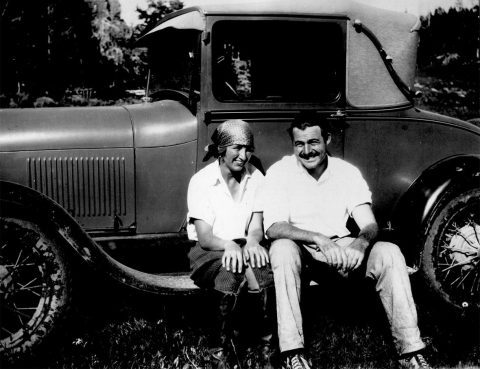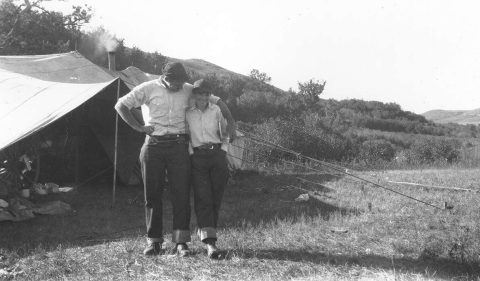Author Ernest Hemingway’s impact on American literature is well known. What is perhaps less known is the story of his life and times in Wyoming and how it impacted him as a writer and a man. Yet there are reports going back as far as World War I that suggest Hemingway yearned for the quiet and majesty of the American West – not only as a place to fish for prized trout and hunt for wild game, but as a place where he might fully dedicate himself to his craft.
FOLLY RANCH AND THE SHERIDAN INN
The chapter of the author’s life featuring Sheridan County begins with a search for solitude in the legendary Bighorn Mountains; in the summer of 1928 Hemingway found himself at the Folly Ranch, where, according to a letter penned to a friend, he was “lonely as a bastard” (his wife Pauline would not join him in Wyoming for several weeks). It was Hemingway’s intention to retreat from the world so that he might finish work on A Farewell to Arms, yet the ever affable and often sociable author found himself aggravated by tourists at the ranch, and so he packed up and came down off the mountain to set up at the Sheridan Inn, considered at the time one of the finest hotels west of the Mississippi (a consideration that has not changed in the more than 125 years since the hotel was built).

THE WYO THEATER
Sheridan in the late 1920s was a rip-roaring place, and while Hemingway found some of the peace and quiet he so fervently desired at the Sheridan Inn, there were also many distractions to occupy a young man’s attention. One of those distractions was the WYO Theater, known then as the Lotus. The Lotus was famous in its time for its Vaudeville acts, but also for its showing of early motion pictures. The theater was lauded as Wyoming’s Wonder Picture Palace, given its state-of-the-art chops, and ability to show the most modern films and performances. The WYO, since its opening in 1923, has always been deeply tied to the cultural heart of Sheridan. In fact, when the first talkies were shown in 1929, hundreds of people from all over Northern Wyoming flocked to Sheridan for the event. And in the mid-1930s, when Sheridan’s reputation as a dude ranching mecca reached its zenith, the Lotus was rebranded the “Western Theater for Western People.” A remodeling dressed the theater in massive log slabs, pine panels, huge western murals, buffalo heads, and Indian rugs. It’s really no surprise why Hemingway loved to visit this place, when it was charged with so much energy.
THE MINT BAR AND THE LAST CHANCE SALOON
There were plenty of other distractions for young Ernest back in those early days. Remember that he visited during Prohibition, when booze flowed more freely than perhaps any other time in American history. One place he loved to imbibe was the Mint Bar, a watering hole that needs no introduction. From its time as The Mint Cigar Company and Soda Shop with a speakeasy run in the back room during the sneaky times of Prohibition, to the multiple times horses stopped in for a drink, The Mint Bar has served as a backdrop for the personal mythologies of generations. Hemingway was also fond of the Last Chance Saloon in Big Horn, aptly named because it was the last place to find a drink before heading up the treacherous mountain road toward Folly Ranch or Spear-O-Wigwam. The building then known as the Last Chance has been renamed and remade as the Just Ledoux It Steak-Out and Saloon, while the spiritual successor to that famous establishment, the modern Last Chance Bar, is just down Johnson Street in Big Horn.
Hemingway famously loved his drink, but he was also a veracious carnivore. While in Wyoming, Hemingway served his friends a lunch of bear steaks: “The meat was rank and stringy, cooked middling rare, and eaten in the form of sandwiches made from sourdough pancakes spread with orange marmalade. But Ernest consumed his portion with evident gusto, chewing long and appreciatively, his black beard glossy with bear fat,” said a friend.
SPEAR-O-WIGWAM
Anecdotes from Spear-O-Wigwam detail Hemingway’s love for Sheridan County’s high country. High in Wyoming’s Bighorn Mountains at the end of a 30-mile road stands a small log cabin by a rushing stream. There is nothing extraordinary about the building or the simple furnishings inside: a bed, a desk, and a stone fireplace. But for a few weeks in 1928, this humble cabin at the Spear-O-Wigwam ranch served as the writing workshop for Ernest Hemingway, one of the giants of American literature.
What was it about Spear-O-Wigwam and the Bighorns that attracted the 29-year-old Hemingway? Earlier in the summer he’d been a guest at the nearby Folly Ranch with a friend from Kansas City, and then spent time at the Sheridan Inn. Neither place afforded the privacy or the solitude he needed to work on the manuscript that was slowly taking shape in his mind. In the cabin at Spear-O-Wigwam he found the combination of cool mountain air and the quiet he needed to put his thoughts to paper.
Many of Hemingway’s writings feature fishing and the outdoors as central joys in his life. At Spear-O-Wigwam he could wake up in the morning, walk over to the council lodge and have a big breakfast of steak and four eggs. Those who shared the table with him said he reached for what he wanted without asking, and that he swore unapologetically. He then retreated to his cabin to concentrate on his writing until afternoon. After lunch he would venture out with his wife Pauline to fish for trout in the many mountain lakes, a pastime that afforded plenty of time for inspiration to surface.

Hemingway was able to complete the first draft of A Farewell to Arms in a few weeks at Spear-O-Wigwam. The semi-autobiographical novel was serialized in Scribner’s the following summer from May to October 1929, bringing Hemingway international acclaim as the Great Depression began. Even today, the book is recognized as an emblematic narrative of the World War I generation. To some extent, his fruitful stay at Spear-O-Wigwam likely contributed to his lasting affection for the state. He once said, “There are two places I love: Africa and Wyoming.”
THE BACKYARD
For more on Hemingway’s connection to Sheridan County we encourage you to watch our special episode of The Backyard – this episode, titled “Death in the Mountains,” premiered at the WYO Theater Festival in 2020.
Death on the Mountains alludes to Hemingway’s non-fiction book about Spanish bullfighting. The book is a remarkable exploration of the nature of fear and courage, which, put simply, could define any grand adventure in the Bighorn Mountains. To that end, our story is not about death being an end, but of the death of old things, and the beginning of new experiences. Of how the mountains change us, and of how Wyoming becomes a critical part of ourselves.
WYO History has a fascinating story on Hemingway available at this link.
For more info on fishing in Sheridan County check out our resources here.

